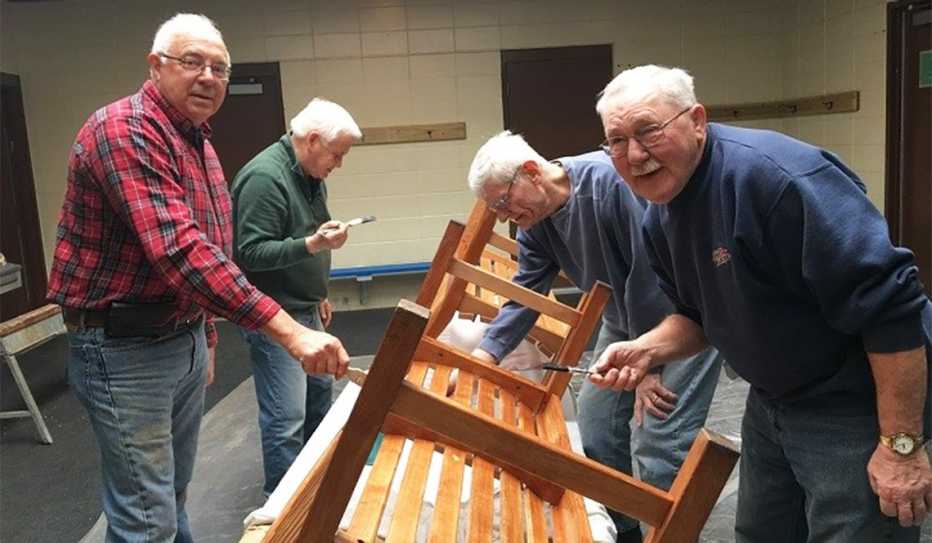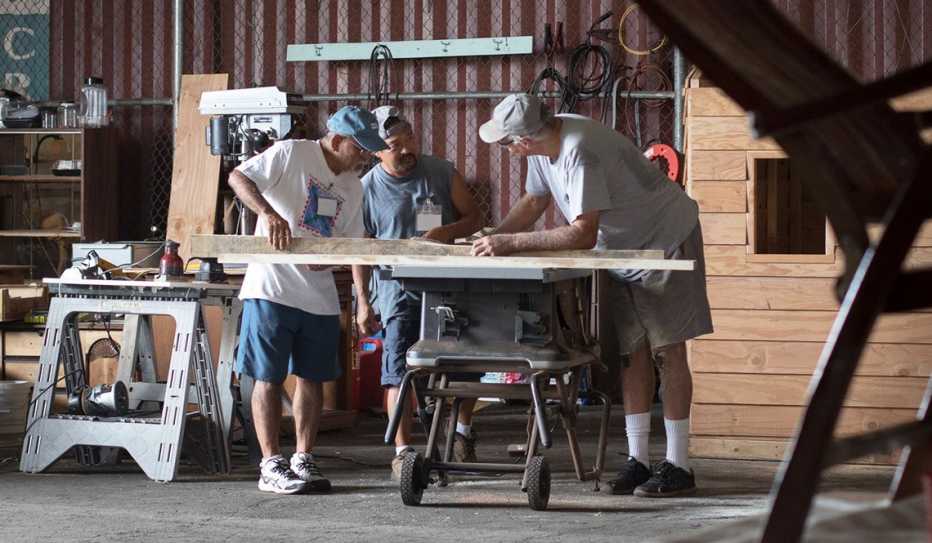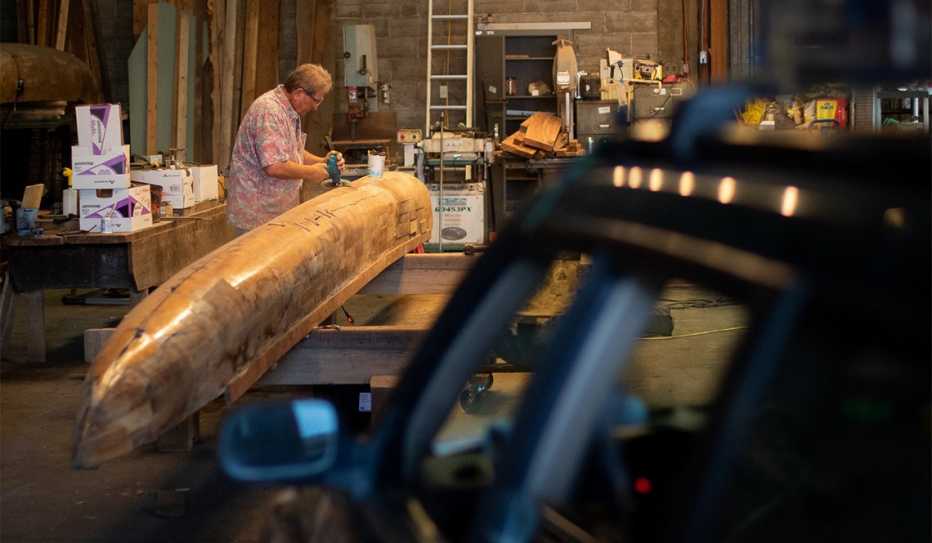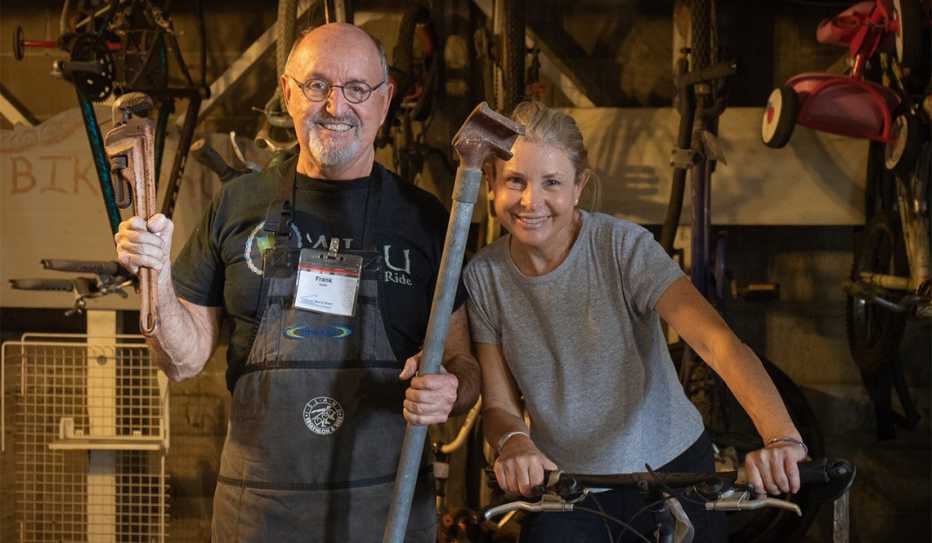AARP Hearing Center


Read "How to Start a Shed" at the end of this article.
Square dance music wafts in from next door, as 16 gentlemen in their 60s, 70s and 80s gather for the Tuesday meeting of the Men’s Shed in the Hopkins Activity Center — located just west of Minneapolis, Minnesota.
“Hey, everyone, I brought my friend Stan,” announces a guy dressed in a flannel shirt, like half of the men in the room.
“Don’t worry Stan,” someone pipes up. “We won’t start razzing you until you’ve been here a few times.”
“Who’s going out on Saturday to distribute the bikes we fixed up for kids?” asks another guy. “There’s no sense all of us driving alone.”
Many if not most retired men don’t want to square dance, do yoga or participate in many of the other activities common to senior centers. But they do want to get out of the house. Although not literally a shed, Men’s Sheds serve as a place for hanging out.
“This is like Boy Scouts for men, except you don’t have to earn merit badges,” says Phil Johnson, cofounder of the Hopkins Center shed.
Or maybe it’s more like shop class. “The smell of turpentine or linseed oil is like aromatherapy for these guys,” observes health educator Peggy Gaard, who was at the Hopkins gathering to give a presentation on how symptoms of dementia differ from the typical signs of aging. (Sheds also provide an audience for health education and outreach efforts that are targeted to older men.)
Sheds Come From the Land Down Under
“Retired blokes can’t wait to go into the shed and make sawdust,” declares David Helmers, executive officer of the Australian Men’s Shed Association. The Men's Shed as a productive place for older men was born in Australia in the 1990s.
Two decades later, there are about 1,000 sheds across Australia, roughly 450 in Ireland, 300 in the United Kingdom, 100 in New Zealand and 20 in Canada. Men’s Sheds are newly taking root in the United States. The Hopkins shed was among the first in the U.S. when it debuted in 2017. At the start of 2019, the number had grown to more than a dozen in eight states.
“Guys say they're going to the shed to help the community,” Helmers explains. “But they're also going for themselves.”


From Pilot to Shed Builder
Phil Johnson was 67 when he created the Hopkins Activity Center Men's Shed, which he did to make sure he didn’t spend his retirement sitting on the couch.
Johnson led a very active life: Marine Corps fighter pilot, pilot for an aerial photography firm, sales and marketing manager, software developer, and the development director for USA Track and Field (he helped create a women’s pole vaulting team for the 2000 Olympics). His father led an active life as well — until he retired.
“For the last 20 years of his life it was hard to get him to do anything,” says Johnson. “When I had been retired for about a year and got all the stuff that needed doing around the house done, I Googled ‘retired men’s activities.’ 'Men’s Shed' was the first thing that came up, so I contacted a group in Ireland about how to start one.”
When Johnson brought the Men's Shed idea to the Hopkins Activity Center, they were looking to create more programs for older men. “It was a perfect fit for us!” says Susan Newville, the center's director.
Johnson helped form the U.S. Men’s Sheds Association in 2017, and was recognized for his work by being named to AARP Minnesota’s honor roll of 50 over 50 leaders. The Hopkins Center Men's Shed has inspired sheds in three other Minnesota communities (Roseville, New Brighton and Willmar) and two in Wisconsin (Platteville and Oconomowoc).
A Solution to Social Isolation
On the day of AARP’s visit to the Hopkins Center, the activity for the Men's Shed was atypically arts ‘n crafty. The task: decorate 300 paper grocery bags that will be used to distribute food to low-income families. But the guys happily tear into the job, wielding glue sticks to affix butterflies, flowers and other artwork so efficiently that the job is finished in half an hour.
Since the shed’s launch, the collective of about 25 men have built, fixed, replaced, assembled, dismantled, installed, scraped, sanded, varnished, painted, stained and organized all kinds of stuff for the Hopkins Activity Center, the city parks department and local nonprofits.
“One time we even fixed a blender for a lady who lived in a senior housing building next door,” Johnson explains. “The problem was only a gasket, but she thought we were geniuses.”
The members also take field trips, including to the Minnesota State Capitol, Federal Reserve Bank, National Weather Service center, a brewery, an aviation museum, a recycling plant and a police station.
“Once retired, we men may feel useless and underfoot, bored and depressed,” Johnson observes. “We’re programmed to be independent and not ask for help. We don’t realize the enrichment from being with others.” He notes how medical studies link loneliness with strokes, high-blood pressure and weakened immune systems.
People over 60 who report feeling lonely face a 45 percent higher risk of death, and are 59 percent more likely to suffer mental and physical decline, according to a study by the geriatrics department of the University of California, San Francisco.
Thirty-five percent of Americans over the age of 45 experience chronic loneliness, reports a 2018 AARP survey — up from 20 percent in 2000. Social isolation, especially among older men, is a growing concern. “They often identify with their job, and when they retire they think they are going to keep the same friends they’ve had in the workplace, but then they find they no longer share the same interests,” explained Charlotte S. Yeh, chief medical officer of AARP. “Then they may depend on their spouses to develop networks, but they might not have spouses, or that might not work out.”


Hawaii 5-0
In 2016, Glenn Sears, an octogenarian and retired engineering professor who once built his own house by hand, was living in Honolulu, feeling bored and lonely. Although he’d grown up in Hawaii, none of his old friends lived nearby, and he’d given away all his tools after moving to the 35th floor of a condominium building.
“One day my wife comes in and says, ‘I’ve found what you’ve been looking for,’ and showed me an article about Australian Men’s Sheds,” recalls Sears.
He contacted the Australian Men’s Shed Association, hoping to find a U.S.-based shed to join. “We wondered when you Yanks were going to start a men’s shed,” they said. “Glad that you’re willing to do it.” While attending a meeting of his wife’s Rotary Club, Sears recruited four guys on the spot to help him start the shed.
On Wednesday and Saturday mornings about 100 men gather inside a 7,000-square-foot warehouse from 9 a.m. until whenever people are ready to go home. The big draw is a treasure chest of tools donated through a Craig’s List ad. “We've got drill presses, lathes, tables saws,” Sears says proudly. “Old tools, but excellent ones.”
The shed’s first meeting spot was in an unused room inside of a senior center, but the parks department rescinded the offer at the first mention of power tools. “No sharp objects,” they told him. A state senator who was excited about the idea offered the use of a vacant warehouse — if the men first removed the 28 tons of concrete debris littering the property. Five-dozen volunteers joined the cleanup, some with their own jackhammers.
Members are free to work on projects at the shed whenever they want to, so long as at least two people are present and one is certified in first aid.
At least one shed member is known to have been diagnosed with dementia. “He wasn’t able to speak a complete sentence when he started coming to the shed,” Sears says. “But now he speaks pretty well when he’s here.” The tool that interests him most is a saw, which he plays as a musical instrument. “We all whistle songs we want to hear, and that helps him remember the tunes,” explains Sears.


Behind Many Great Men’s Sheds Was a Great Woman
Not all Men’s Sheds are centered around making things.
There’s not a hammer or screwdriver in sight when the North County Men’s Shed convenes on Wednesday afternoons at a senior activity center in Palm Beach Gardens, Florida. “We don’t do woodworking but otherwise we’re like other sheds,” says founder Steve Werner. “We share stories and build camaraderie, but we do it by offering presentations.”
Since the fall of 2018, shed members have learned CPR, tested new cooking appliances, practiced balance exercises, boosted their financial literacy, explored the art of tapestry-making, boned-up on the warning signs of a computer scam, and enjoyed a behind-the-scenes tour of the Palm Beach Zoo. Planned activities include a preview of future space exploration, a clinic on eye health, and a private viewing of the South Florida Science Center’s new exhibit about the brain. Members also connect for breakfast and a regular round of potluck dinners.
When Werner moved to Florida in 2016, he vowed to devote himself to golf. “But after about a year I started to get bored,” he explains. As happened with Glenn Sears in Hawaii, his wife showed him a newspaper article. (This one was about the U.S. Men’s Shed Association.) Explains Werner: “So I got in touch and they said there were none in South Florida, so I decided to start one.”
Werner and three friends (one a woman) formed the steering committee. “Women play a big role in encouraging men to get involved in Men’s Sheds,” he notes. Indeed, the very first men’s shed was launched by a woman named Maxine Kitto when, according to Barry Golding, a professor of adult education and author of The Men’s Shed Movement: The Company of Men, she noticed that her organization’s health services aimed at older people in rural Australia were used primarily by women.
Some Men’s Sheds around the world have women members, and there are at least a half-dozen exclusively female sheds in Australia. But for many women, the value of Men’s Sheds is how they help the men in their lives. When NBC’s Today show aired a segment about a Men’s Shed in Traverse City, Michigan, the U.S. Men’s Shed Association received nearly 100 emails within three hours of the broadcast, notes Phil Johnson. A good share of the messages were from women who believed their husband, father or male friends very much needed a shed.


How to Start a Shed
1. Contact an Existing Shed
Visit the U.S. Men’s Sheds Associations' website to see if there’s already a shed nearby. As of June 2019, there are four in Minnesota, three in Hawaii, two in Wisconsin, and one each in Michigan, Illinois, Louisiana, Washington and Florida. Groups are forming in Colorado, Georgia, Pennsylvania and Arizona. Advice from an existing shed can be useful in starting a shed. (The Hopkins shed, for instance, mentored the founders of sheds in Minnesota and Wisconsin.)
2. Find a Host
Aligning with a local service organization or public facility is often the easiest, cheapest and fastest way to get rolling. On the down side, a shed may be bound by the rules, hours and liability concerns of the group or location. Most sheds like the convenience of an established meeting place that is familiar to people. Others have opted to strike out on their own. The guide Starting a Men’s Shed from the U.S. Men’s Sheds Association lays out the details of each approach.
3. Form a Working Group
These can be friends and neighbors with a shared interest or experience organizing informal informational events. Get together to craft a vision for the shed, and then map out ways to make it happen. Local nonprofits, charities, community organizations and social service agencies can all be helpful in spreading the word to potential members as will publications and social media channels geared toward older residents.
Don’t try to do the work alone, counsels Steve Werner of the Palm Beach County shed. He enlisted three acquaintances as a Men’s Shed steering committee. “We all sat around my table the night before our first public meeting, asking one another, 'Do you think anyone will come?' Eight people showed up and we’ve been going ever since.”
4. Be Flexible
And be ready to tweak your plans based on members’ preferences. Johnson and his Hopkins shed cofounders were imagining a wood shop as their main activity. “But several who came weren’t woodworkers,” he explains, noting that in Ireland, which has more Men’s Sheds per capita than any other nation, a common activity is singing and playing music together.
Glenn Sears reports that one of the most popular events for the Honolulu shed is about grilling not drilling — the monthly “sausage sizzle,” which adopts the down-under term for a cookout to honor the Australian origins of the movement.
Jay Walljasper is a Minnesota-based journalist and author of The Great Neighborhood Book. He writes, speaks and consults about livable communities.
Page published June 2019































.jpg?crop=true&anchor=13,195&q=80&color=ffffffff&u=lywnjt&w=2008&h=1154)




























